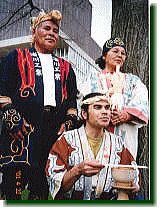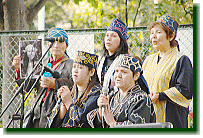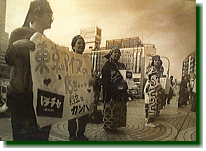|
 |
| Back to Main Page |
  |
 Kanto Utari Association Kanto Utari Association |
Established in 1980 in order to enhance interactions among the Ainu living
in Greater Tokyo and their families, to promote traditional Ainu culture
and to eliminate racism and prejudice against the Ainu. Activities include
regular meetings to learn the Ainu culture, songs and dances, embroidery
and musical instruments such as the Tonkori (the Ainu string instrument) and Ainu language classes for mothers and
children (now temporarily closed). The Association holds the Ainu Embroidery
Exhibition every year, which is open to the public free of charge, and
an open study session on the Ainu culture and human rights.
The Association took the lead in voicing objections when then Prime Minister Nakasone made a remark in 1986 that Japan was an ethnically homogeneous nation.
|
|
 Tokyo Ainu Association Tokyo Ainu Association |
Established in October, 1996 with its membership consisting of Ainu whose
hometown is Urakawa, Hokkaido. The current President, Haruzo Urakawa, opened
Kamuy Mintara, an Ainu cultural facility, in Kimitsu, Chiba Prefecture in 2005. Its
opening was celebrated by many local people as well as indigenous guests
from the U.S. and Canada. The Association held the “Kamuy Nomi” (an Ainu ceremony to offer prayers to the God of Fire) and the “Icarpa” (an Ainu ceremony to commemorate ancestors) at a treatment house for Hansen’s
disease patients in Miyazaki.
|
|
 |
Elder Shizue Ukaji, a noted Ainu embroidery artist and activist, published
children’s books illustrated by her unique “kofue” technique, which uses old Japanese cloths and creates pictures by attaching
pieces of appliqué fabric on the background cloth with Ainu embroidery.
The two elders, Urakawa and Ukaji, along with Vice President Takumi Hoshino,
were invited to make presentations at Harvard University and MIT in 2001.
In May 2008, Kamuy Mintara held a spring festival featuring an Ainu cultural preservation group from Mukawa, Hokkaido, and other international performers from Australia, Ukraine, etc. |
|
 Pewre Utari Association Pewre Utari Association |

at Charanke Festival
(Photo Maki Yanagimachi) |
|
“Peure” is an Ainu word meaning young and “utari” means fellow people. The Association was established in summer 1964, as
a result of interactions between the Ainu and the non-Ainu Japanese who
worked at Lake Akan, Hokkaido. For 45 years since then, the Ainu and Japanese
members have been learning the Ainu language, songs and dances, and other
aspects of the Ainu culture. It organizes study sessions and symposiums
and participates in events such as the annual Charanke Festival held at Nakano, Tokyo.
|
Another feature of the Association is its social awareness raising activities
through which the members promote Ainu human rights and aim to create a
society free of discrimination and prejudice.
|
|
 Rera Association Rera Association |
The Rera Association started in 1983 as the Rera Association for Contemplating
the Current Situation of the Ainu People. Its activities aim to recover
Ainu rights, inherit the Ainu culture and raise awareness on Ainu issues.
In 1994, it opened Rera-Cise, an Ainu restaurant, with the help of many supporters.
The Association is a main organizer of “Tokyo Icarpa—Sinritumosir Koicarpa”, an ancestral commemoration ceremony for the Ainu who were forcibly brought
to Tokyo to attend the Hokkaido Aboriginal Training School in 1872 and
died in Tokyo far away from their homeland. The ceremony is held at Shiba,
Minato-ku, Tokyo every August.
|
|

Street Campaign for
the fund raising
(Photo Makiko Ui) |
|
 Other Ainu-related Facilities Other Ainu-related Facilities |
Ainu Culture Center (Yaesu, Tokyo)
A branch of the Foundation for Research and Promotion of Ainu Culture,
this is a multi-purpose center to support interactions among the Ainu in
Greater Tokyo and their cultural activities as well as to promote interactions
between the Ainu and the non-Ainu and to collect and disseminate information
on the Ainu culture.
|
Rera-Cise (Nakano, Tokyo)
The only Ainu restaurant in Tokyo, established as a base for Ainu activities
and for the dissemination of information relating to the Ainu culture with
a focus on Ainu food. The evening menu includes salmon and venison dishes
(these were a staple food for the Ainu), other traditional and contemporary
Ainu dishes and local Hokkaido dishes. Gourmet lunch is also served: miso-flavored
Ramen with “kitopiro” (a wild leek commonly eaten by the Ainu, with a flavor similar to garlic,
and difficult to get in urban areas) on Tuesday through Thursday and venison
or salmon curry on Friday through Sunday. Ainu language classes and mini
Ainu and Ryukyu live performances are also held. Closed on Monday.
|
|
|
|